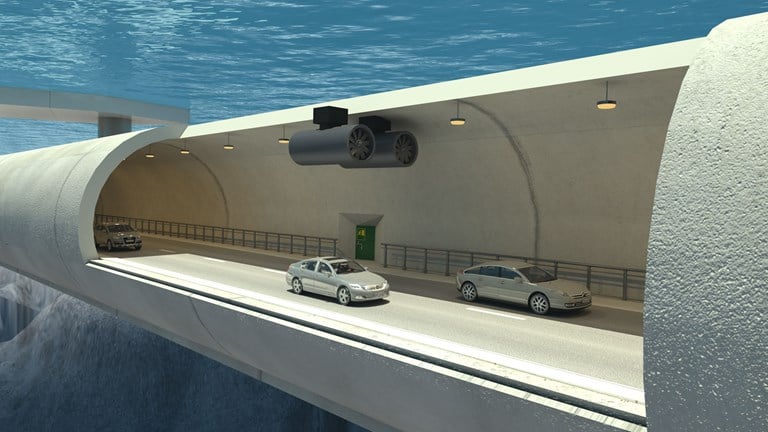Norway takes on its largest infrastructure project in modern history
The Coastal Highway Route E39-project is the largest infrastructure project in modern Norwegian history, and quite possibly the largest ongoing road project worldwide.
The rugged west coast of Norway, home to thousands is a challenge to travel by car. It takes time. A long time…
The harsh weather conditions also makes it an unpredictable route, with closed roads and ferries often having to cancel their departure due to snow, heavy winds or high waves. A continuous E39 highway that is accessible 24/7, with fixed links between islands and the mainland will make the western coast more accessible for people who inhabit the coast, but also for tourists and for transportation of goods. About one third of Norway’s population of 5.3 million live in the western region.
1100 kilometres of roads to be improved
The Norwegian parliament (Stortinget) has a long-term goal to develop the E39 as an improved and continuous Coastal Highway Route between the cities of Kristiansand in the south and Trondheim in the north within 2050. The Norwegian Public Roads Administration is the contractor for the project, comprising 1100 kilometres. The route runs through six counties, and the cities of Stavanger, Bergen, Ålesund and Molde. The total travel time today is around 21 hours, and road users need to use seven different ferry connections. The aim is to create an improved E39 without ferries, which will reduce the travel time by half. The route will be almost 50 kilometres shorter. The reduction in travel time will be obtained by replacing ferries with bridges and tunnels, in addition to upgrading a number of road sections on land. -60 percent of Norway’s export goods is produced on the west coast, so an efficient and predictable transport system will be a great benefit for national economy, but by connecting cities along the west coast we will also be creating new patterns of habitation. The new road will shorten the path to reach hospitals, jobs and schools. The E39 continues to Denmark, and hence connects Norway with southern Europe. Preliminary estimates show that the required investments and improvements will cost approximately NOK 340 billion.
Could Norway build the world’s first submerged floating tube bridge?
- To replace todays seven ferries we are planning to build alternative constructions, either bridges or tunnels. We are considering a new type of structure, a Submerged Floating Tube Bridge (SFTB) for some of the deepest and longest fjords exposed to harsh weather conditions, where also suspension bridges or floating bridges will be difficult to build. When a fjord is deeper than some hundred meters or wider than 2-3 kilometers, existing engineering solutions aren’t applicable. The seabed would be too deep for a traditional rock tunnel because it will imply the use of a huge amount of land on the shores. Floating bridges and other type of bridges on tension leg platforms (TLP), even if they are suitable for deep crossings, they are susceptible to harsh weather conditions such as strong waves and currents. This is how the SFTB has become an attractive solution for some of the longest and deepest fjords, because its submergence can naturally reduce the main sea load.
The tube would be placed underwater, deep enough to avoid water traffic and reduce the main sea load, but not so deep that high water pressure needs to be dealt with—usually 20–50 m (60–150 ft) is sufficient. Tethers anchored to the seabed or pontoons floating at the surface would provide the vertical stability.
- We are performing tests to see what the driver experience will be, and of course, safety is our first priority whenever we plan any type of construction for transport. Fires and explosions are some of the loads that are included in the design, since the early phases. We are planning some scale test for fire and explosion loads, also to take into consideration the possibility of having, for example, a truck carrying dangerous goods exploding inside the tunnel. Another risk is of course ship collisions or submarine collisions, as the fjords also are a training field for the Norwegian navy.
-The submerged floating tube bridge is certainly an engineering marvel, but the idea isn’t new! The first known proposal was in 1886 by UK naval architect Sir James Edward Reed. In Norway the idea was studied since 1923 and, after the studies performed by the Norwegian Public Road Administration for the E39, we know that several other countries are considering building the same type of structure. We are in dialogue with several of them, so it is more of a collaboration than a competition, but I have to admit that it will definitely be exciting to see who will be the first country to build this structure! We are still evaluating some fjords the SFTB might be relevant for, and some of them are among the longest and deepest.
Research is necessary for the future digital transportation system
The Coastal Highway Route project collaborates with three of the largest universities in the Nordic region (The Norwegian University of Science and Technology, The University of Stavanger and Chalmers University of Technology), and has about 50 PhD-candidates working on solving different engineering challenges related to the E39-project.
It is clear that a lot of the research ongoing is of interest not only for the E39 Coastal Highway Route, but to the whole road system worldwide. We have done and we are doing a huge effort for disseminating the results of our research, so that every part of the work we are doing can contribute to the international knowledge and not being wasted.
Some of the research topics in the E39-project:
- Sustainable infrastructure, how to reduce greenhouse emissions
- Wind measurements
- Bridge technology for future structures (e.g. long suspension bridges)
- Electric infrastructure (Building roads that demand less fuel (hence our country’s strategy on electrical vehicles, Norway is the country in the world with the highest rate of electric cars)
- Electric infrastructure and intelligent transport systems (ITS)
- How to operate and maintain the structures digitally
- Societal impacts of infrastructure projects
- Financial gains
- Contract strategies in complex engineering projects
- How to use local masses in road construction
- How to ensure ice-free road surfaces in winter by solar energy
- How to avoid corrosion or microbiological degradation of concrete
Read more about the Submerged Floating Tube Bridge (Wikipedia)
Watch Arianna Minoretti present the SFTB
About Arianna Minoretti:
Arianna Minoretti was born in Italy in 1979. She graduated at Politecnico di Milano, in Structural Engineering. She is a chief engineer in the Norwegian Public Roads Administration, department of bridges and is responsible for the studies on the Submerged Floating Tube Bridge.

